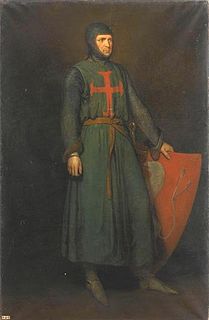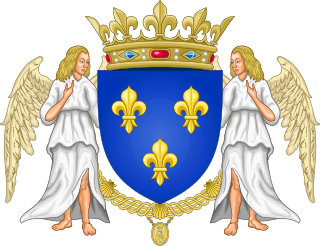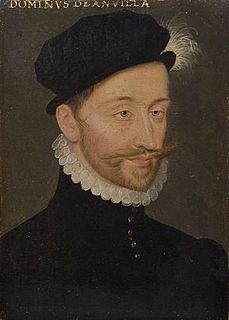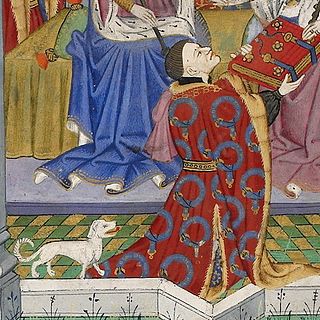 W
WThe Grand Constable of France, was the First Officer of the Crown, one of the original five Great Officers of the Crown of France and Commander in Chief of the King's army. He, theoretically, as lieutenant-general to the King, outranked all nobles in the realm, and was second-in-command only to the King of France.
 W
WCharles I d'Albret was Constable of France from 1402 until 1411, and again from 1413 until 1415. He was also the co-commander of the French army at the Battle of Agincourt where he was killed by the English forces led by King Henry V.
 W
WAmaury de Montfort was the son of Simon de Montfort, 5th Earl of Leicester and Alix de Montmorency, and the brother of Simon de Montfort, 6th Earl of Leicester.
 W
WBernard VII, Count of Armagnac was Count of Armagnac and Constable of France. He was the son of John II and Jeanne de Périgord. He succeeded in Armagnac at the death of his brother, John III, in 1391. After prolonged fighting, he also became Count of Comminges in 1412.
 W
WCharles III was a French military leader, the count of Montpensier, Clermont and Auvergne, and dauphin of Auvergne from 1501 to 1523, then duke of Bourbon and Auvergne, count of Clermont-en-Beauvaisis, Forez and La Marche, and lord of Beaujeu from 1505 to 1521. He was also the constable of France from 1515 to 1521. Also known as the constable of Bourbon, he was the last of the great feudal lords to oppose the king of France. He commanded the troops of Holy Roman Emperor Charles V in what became known as the Sack of Rome in 1527, where he was killed.
 W
WArthur III, more commonly known as Arthur de Richemont, was briefly Duke of Brittany from 1457 until his death. He is noted primarily, however, for his role as a leading military commander during the Hundred Years' War. Although Richemont briefly sided with the English once, he otherwise remained firmly committed to the House of Valois. He fought alongside Joan of Arc, and was appointed Constable of France. His military and administrative reforms in the French state were an important factor in assuring the final defeat of the English in the Hundred Years' War.
 W
WHumphrey Stafford, 1st Duke of Buckingham, 6th Earl of Stafford, of Stafford Castle in Staffordshire, was an English nobleman and a military commander in the Hundred Years' War and the Wars of the Roses. Through his mother he had royal descent from King Edward III, his great-grandfather, and from his father, he inherited, at an early age, the earldom of Stafford. By his marriage to a daughter of Ralph, Earl of Westmorland, Humphrey was related to the powerful Neville family and to many of the leading aristocratic houses of the time. He joined the English campaign in France with King Henry V in 1420 and following Henry V's death two years later he became a councillor for the new King, the nine-month-old Henry VI. Stafford acted as a peacemaker during the partisan, factional politics of the 1430s, when Humphrey, Duke of Gloucester, vied with Cardinal Beaufort for political supremacy. Stafford also took part in the eventual arrest of Gloucester in 1447.
 W
WCharles de la Cerda, commonly known as Charles of Spain, was a Franco-Castilian nobleman and soldier, the son of Alfonso de la Cerda of Spain and Isabelle d'Antoing, and grandson of Alfonso de la Cerda the disinherited (1270–1333). He was a distant cousin of John II of France.
 W
WGaucher V de Châtillon, Lord of Châtillon, Count of Porcien, was constable of Champagne in 1284 and then Constable of France (1302–1329) during the reigns of five different kings. He was also tutor to the future Louis X of France and his primary minister.
 W
WRaoul II/III of Clermont-Nesle was Seigneur (Lord) of Nesle in Picardy (de), Viscount of Châteaudun (de), Grand Chamberlain of France and Constable of France.
 W
WOlivier Le Vieux de Clisson, dit Olivier V de Clisson, nicknamed "The Butcher", was a Breton soldier, the son of Olivier IV de Clisson. His father had been put to death by the French in 1343 on the suspicion of having willingly given up the city of Vannes to the English.
 W
WBertrand du Guesclin, nicknamed "The Eagle of Brittany" or "The Black Dog of Brocéliande", was a Breton knight and an important military commander on the French side during the Hundred Years' War. From 1370 to his death, he was Constable of France for King Charles V. Well known for his Fabian strategy, he took part in six pitched battles and won the four in which he held command.
 W
WThe House of Valois was a cadet branch of the Capetian dynasty. They succeeded the House of Capet to the French throne, and were the royal house of France from 1328 to 1589. Junior members of the family founded cadet branches in Orléans, Anjou, Burgundy, and Alençon.
 W
WJames I of Bourbon, was the son of Louis I, Duke of Bourbon and Mary of Avesnes. He was Count of Ponthieu from 1351 to 1360, and Count of La Marche from 1341 to his death.
 W
WFrançois de Bonne, duc de Lesdiguières was a French soldier of the French Wars of Religion and Constable of France.
 W
WCharles II, called the Bold was the Duke of Lorraine from 1390 to his death and Constable of France from 1418 to 1425. Charles was the elder son of John I, Duke of Lorraine, and Sophie, daughter of Eberhard II, Count of Württemberg.
 W
WLouis de Luxembourg, Count of Saint-Pol, of Brienne, de Ligny, and Conversano belonged to the Ligny branch of the House of Luxemburg and was Constable of France.
 W
WCharles d'Albert, Duke of Luynes was French courtier and a favourite of Louis XIII. In 1619, the king made him Duke of Luynes and a Peer of France, and in 1621, Constable of France. Luynes died of scarlet fever near the end of that year at the height of his influence.
 W
WMatthew II or Mathieu II, called the Great or the Great Constable, was lord of Montmorency from 1189 and Constable of France from 1218 to 1230.
 W
WAnne, Duke of Montmorency, Honorary Knight of the Garter was a French soldier, statesman and diplomat. He became Marshal of France and Constable of France and served five kings.
 W
WHenri I de Montmorency, Marshal of France, and Constable of France, seigneur of Damville, served as Governor of Languedoc from 1563 to 1614.
 W
WPhilip of Artois, son of John of Artois, Count of Eu, and Isabeau of Melun, was Count of Eu from 1387 until his death, succeeding his brother Robert.
 W
WSir John Talbot, 1st Earl of Shrewsbury, 1st Earl of Waterford, 7th Baron Talbot, KG, known as "Old Talbot", was an English nobleman and a noted military commander during the Hundred Years' War. He was the most renowned in England and most feared in France of the English captains in the last stages of the conflict. Known as a tough, cruel, and quarrelsome man, Talbot distinguished himself militarily in a time of decline for the English. Called the "English Achilles" and the "Terror of the French", he is lavishly praised in the plays of Shakespeare. The manner of his death, leading a charge against artillery, has come to symbolize the passing of the age of chivalry. He also held the subsidiary titles of 10th Baron Strange of Blackmere and 6th Baron Furnivall jure uxoris.
 W
WJohn Stewart, Earl of Buchan was a Scottish nobleman and soldier who fought alongside Scotland's French allies during the Hundred Years War. In 1419 he was sent to France by his father the Duke of Albany, Regent of Scotland, with an army of 6,000 men. Stewart led the combined Franco-Scottish army at the Battle of Baugé on 21 March 1421, where he comprehensively defeated the English forces, proving that the English could at last be beaten. However, two years later, Stewart was defeated and captured by Thomas Montacute, 4th Earl of Salisbury at the Battle of Cravant in 1423. After the battle he was exchanged, and after his release in 1424 he was appointed Constable of France making him the effective Commander-in-Chief of the French army. On 17 August 1424 Buchan was killed at the disastrous Battle of Verneuil, along with most of the Scottish troops in France.
 W
WWalter VI was Count of Brienne, Conversano, and Lecce, and titular Duke of Athens as Walter II.